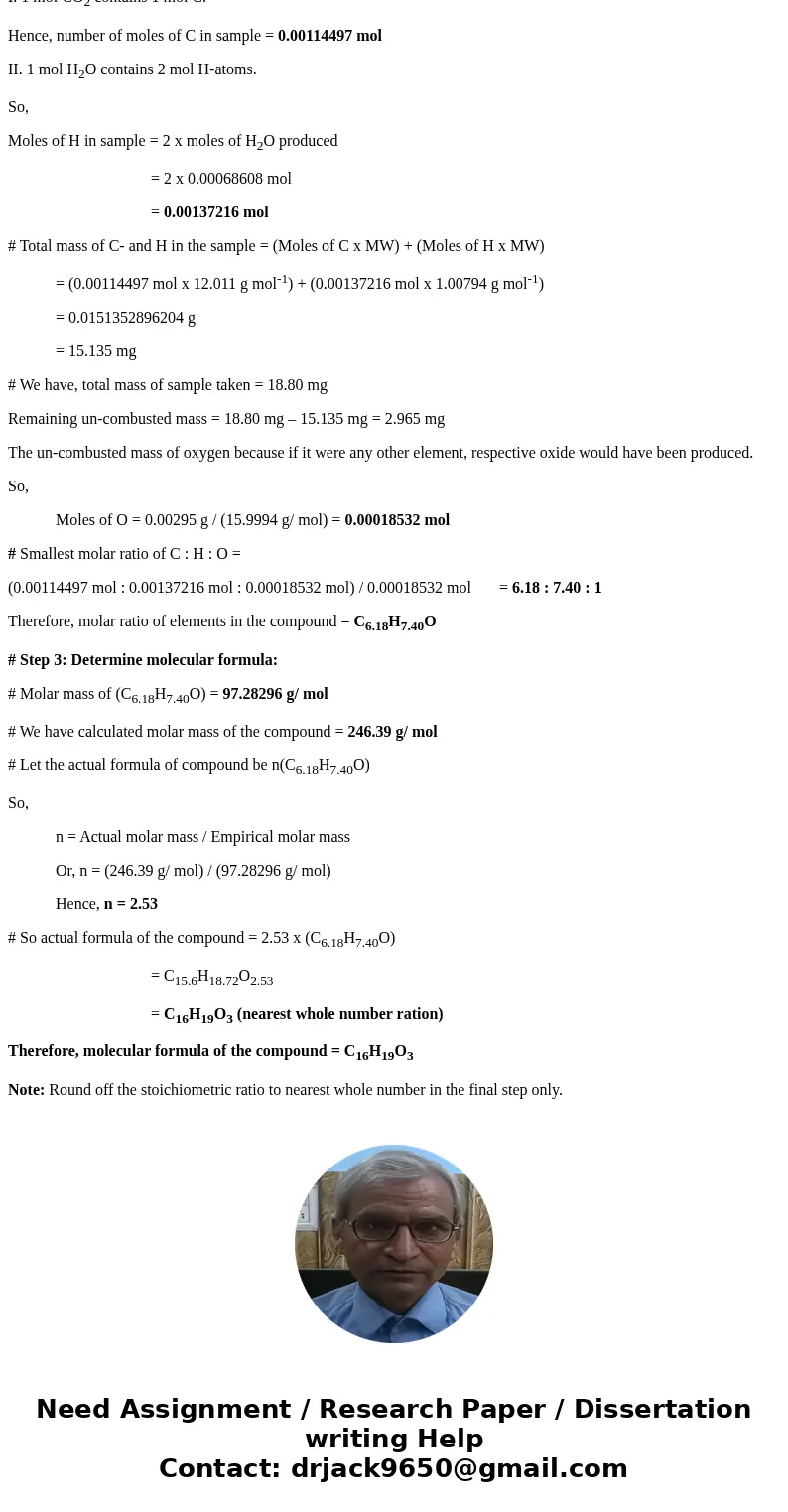19 A 1724 mg sample of a naturally occurring dental anesthet
Solution
Ans. Step 1: Determine molar mass of the compound:
Given
Volume, V = 500.0 mL = 0.500 L
Temperature, T = 280.00C = 553.15 K
Pressure, P = 48.3 mm Hg = (48.3 / 760) atm = 0.0635526 atm
Using Ideal gas equation: PV = nRT - equation 1
Where, P = pressure in atm
V = volume in L
n = number of moles
R = universal gas constant= 0.0821 atm L mol-1K-1
T = absolute temperature (in K) = (0C + 273.15) K
Putting the values in above equation-
0.0635526 atm x 0.500 L = n x (0.0821 atm L mol-1K-1) x 553.15 K
Or, n = 0.0317763 atm L / (45.413615 atm L mol-1)
Hence, n = 6.9971 x 10-4 mol
# Therefore, moles of the compound in flask = 6.9971 x 10-4 mol
# Given, mass of sample = 172.4 mg = 0.1724 g
Now,
Molar mass of the compound = Mass / number of moles
= 0.1724 g / (6.9971 x 10-4 mol)
= 246.39 g/ mol
# Step 2: Determine simple molar ratios of C, H and O:
# Moles of CO2 produced = Mass / Molar mass
= 0.05039 g / (44.0098 g/ mol)
= 0.00114497 mol
Moles of H2O produced = 0.01236 g / (18.01528 g/ mol) = 0.00068608 mol
# Note that-
I. 1 mol CO2 contains 1 mol C.
Hence, number of moles of C in sample = 0.00114497 mol
II. 1 mol H2O contains 2 mol H-atoms.
So,
Moles of H in sample = 2 x moles of H2O produced
= 2 x 0.00068608 mol
= 0.00137216 mol
# Total mass of C- and H in the sample = (Moles of C x MW) + (Moles of H x MW)
= (0.00114497 mol x 12.011 g mol-1) + (0.00137216 mol x 1.00794 g mol-1)
= 0.0151352896204 g
= 15.135 mg
# We have, total mass of sample taken = 18.80 mg
Remaining un-combusted mass = 18.80 mg – 15.135 mg = 2.965 mg
The un-combusted mass of oxygen because if it were any other element, respective oxide would have been produced.
So,
Moles of O = 0.00295 g / (15.9994 g/ mol) = 0.00018532 mol
# Smallest molar ratio of C : H : O =
(0.00114497 mol : 0.00137216 mol : 0.00018532 mol) / 0.00018532 mol = 6.18 : 7.40 : 1
Therefore, molar ratio of elements in the compound = C6.18H7.40O
# Step 3: Determine molecular formula:
# Molar mass of (C6.18H7.40O) = 97.28296 g/ mol
# We have calculated molar mass of the compound = 246.39 g/ mol
# Let the actual formula of compound be n(C6.18H7.40O)
So,
n = Actual molar mass / Empirical molar mass
Or, n = (246.39 g/ mol) / (97.28296 g/ mol)
Hence, n = 2.53
# So actual formula of the compound = 2.53 x (C6.18H7.40O)
= C15.6H18.72O2.53
= C16H19O3 (nearest whole number ration)
Therefore, molecular formula of the compound = C16H19O3
Note: Round off the stoichiometric ratio to nearest whole number in the final step only.


 Homework Sourse
Homework Sourse